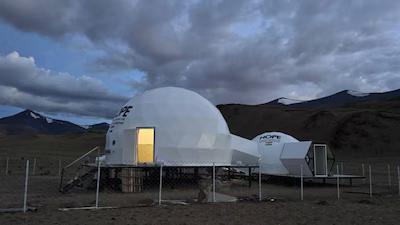
ISRO Sets Up Station in Ladakh to Simulate Life on Moon & Mars
In a significant step towards advancing India’s space exploration capabilities, the Indian Space Research Organisation (ISRO) has set up a unique facility in Ladakh’s Tso Kar Valley, dubbed the Himalayan Outpost for Planetary Exploration (HOPE). The station is designed to simulate the harsh conditions on the Moon and Mars, allowing scientists to test the life-support systems for future lunar and Martian missions.
Located in the Tso Kar Valley, the HOPE station is situated at an altitude of 4,500 meters above sea level. The valley was chosen for its unique environment, which closely resembles the conditions on Mars. The area experiences high levels of UV radiation, low atmospheric pressure, extreme cold, and saline permafrost, making it an ideal location for simulating the Martian environment.
The HOPE station is designed to mimic the conditions on both the Moon and Mars, with the ultimate goal of testing the life-support systems for future missions. The station is equipped with advanced equipment and facilities to simulate the harsh conditions, including temperature control, humidity control, and air circulation systems.
Two crew members will undertake various tests at the facility from August 1-10, marking the beginning of a 10-day simulation mission. During this period, the crew will conduct experiments to test the life-support systems, including air, water, and food supply, as well as power generation and storage.
The HOPE station is a significant milestone in India’s space exploration journey, as it marks the beginning of a new era in planetary exploration. With the station’s ability to simulate the conditions on both the Moon and Mars, ISRO is one step closer to sending humans to these celestial bodies.
Why Ladakh?
The Tso Kar Valley in Ladakh was chosen for the HOPE station due to its unique environment, which closely resembles the conditions on Mars. The area’s high altitude, extreme cold, and low atmospheric pressure make it an ideal location for simulating the Martian environment.
The valley is also home to saline permafrost, which is similar to the Martian soil. This feature is particularly important for future Martian missions, as it will enable scientists to test the feasibility of using Martian soil as a resource for life support systems.
What to Expect
During the 10-day simulation mission, the two crew members will conduct a range of experiments to test the life-support systems. The crew will be responsible for managing the station’s resources, including air, water, and food supply, as well as power generation and storage.
The crew will also conduct experiments to test the station’s ability to recycle resources, including air and water. This will involve testing advanced technologies, such as air recycling systems and water purification systems, to ensure that the station can sustain life for extended periods.
Conclusion
The Himalayan Outpost for Planetary Exploration (HOPE) is a significant step forward in India’s space exploration journey. The station’s ability to simulate the conditions on both the Moon and Mars will enable scientists to test the life-support systems for future missions, paving the way for human exploration of these celestial bodies.
The HOPE station is a testament to India’s commitment to space exploration and its ability to push the boundaries of scientific research. As the country continues to advance its space program, the HOPE station will play a vital role in preparing for future missions to the Moon and Mars.
Source:






